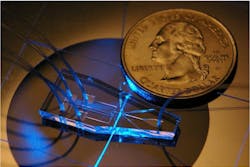Tiny flow cytometry chip could yield faster, cheaper diagnosis of leukemia, HIV
A flow cytometry chip that can produce 3D focusing of a stream of cells developed by researchers at Penn State University (University Park, PA) may make rapid screening of cells for HIV or leukemia possible. HIV diagnosis is based on counting CD4 cells, and 90% of diagnoses are done using flow cytometry, says Tony Jun Huang, associate professor of engineering science and mechanics at Penn State.
Huang and his colleagues designed a mass-producible device that can focus particles or cells in a single stream and performs three different optical assessments for each cell. They believe the device represents a major step toward low-cost flow cytometry chips for clinical diagnosis in hospitals, clinics, and in the field, as current devices are expensive (~$100,000), bulky, complex, and require highly trained personnel, limiting the technique's utility. Recognizing these limitations, the team is aiming to develop a device that costs about $1,000, says Huang.
Flow cytometry uses a tightly focused laser light to illuminate focused cells and produce three optical signals from each cell. These signals are fluorescence from antibodies bound to cells, which reveals the biochemical characteristics of cells; forward scattering, which provides the cell size and its refractive index; and side scattering, which provides cellular granularity. Processing these signals allows diagnosticians to identify individual cells in a mixed cell population, identify fluorescent markers and count cells, and other analysis to diagnose and track the progression of HIV, cancer, and other diseases.
Huang and his team used a proprietary technology named microfluidic drifting to create a focused stream of particles. Using a curved microchannel, the researchers took advantage of the same forces that try to move passengers in a car to the outside of a curve when driving. The microfluidic chip's channel begins as a main channel that contains the flow of carrier liquid and a second channel that comes in perpendicularly that carries the particles or cells. Immediately after these two channels join, the channel curves 90°, which moves all the cells into a horizontal line. After the curve, liquid comes into the channel on both sides, forcing the horizontal line of cells into single file. The cells then pass through a microlaser beam.
An advantage of this microfluidic flow cytometry chip is that it can be mass-produced by molding and standard lithographic processes. The fibers for the optical-fiber delivered laser beams and optical signals already exist.
"The optical fibers are automatically aligned once inserted into the chip, therefore requiring no bulky lenses and mirrors for optical alignment," says Huang. "Our machine is small enough it can be operated by battery, which makes it usable in Africa and other remote locations."
The researchers tested the device using commercially available, cell-sized fluorescent beads. They are now testing the device with actual cells.
The National Institutes of Health, the National Science Foundation, the U.S. Department of Agriculture and the Penn State Center for Nanoscale Science supported this work. The researchers used the Penn State node of the NSF National Nanotechnology Infrastructure Network for this work. The fluidic drifting portion of this project is patented and the researchers filed four provisional patents on other portions of the project.
For more information, please visit http://bmf.aip.org/resource/1/biomgb/v6/i2/p024113_s1?isAuthorized=no.
